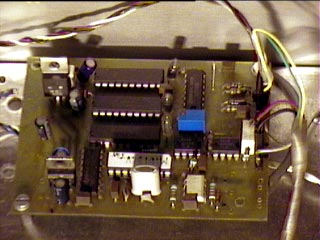 |
MIDI
to CV-Gate Interface MIDI3CV |
 |
 |
|
|
For
analog monophonic CV/Gate synthesizers.

Schematics
and pcb
I
have designed two schematics for the MIDI3CV: "Deluxe" and "Basic".
Each have his
own advantages the other do not have. Both are working with
the same firmware and perform same features: digital architecture
of the circuit remain the same.
- Schematic
of the MIDI3CV - R1 "Deluxe" interface (pdf
95kb)
- Schematic+
pcb for MIDI3CV - R2 "Basic" interface (pdf
185kb)
This table resume
differences between both versions
|
Observation
|
MIDI3CV
r2 Basic
|
MIDI3CV
r1 Deluxe
|
|
Analog
power supply
|
Asymetrical
+12Vmin |
Symetrical
+/-12V min |
| External
PSU |
+15V
DC |
+15VAC
or +/-15V DC |
| DAC
configuration |
Voltage
switched mode |
Current
mode |
| Trim
aops |
Gain
trim |
2
offset trims + Gain trim |
| V
Ref |
+2.5V |
10V
+ trimmer (ajsut 10t) |
| Vref
source |
Resistor
or fixed TL431 |
Ajustable
TL431 |
| Offset
at 0V |
30mV<
x < 40mV |
typ
<2mV , max 5mV |
| Negative
CV |
NO |
YES,
optional offset trim Aux CV |
| Aop
choice |
LM358
or other single supply |
LF411,
TL081 larger choice |
| Ext
mod inputs |
no
implemented but possible |
yes,
one for each aux CV |

|
|
 |
|
 |
 |
|
 |
| |
Important
note for eventual builders...
I have released
many MIDI to CV/Gate in this web site :2 schematics with a PIC16F84
-this page- and 1 schematic with a PIC16F628 named MCV628
. So if you plan to build one of thoses interfaces, i
advise you to build the MCV628
with the PIC16F628 at 20MHz !!!...
I leave informations
on the MIDI3CV , PIC16F84 based interfaces , online only for
people who have already builded one this interfaces... It
work quite well, but it is much better with a PIC16F628
...No doubts !
|
|
 |
|
 |
 |
|
 |
| |
Firmware
for PIC16F84A
The main piece of code, the brain of the interface. The
firmware revision history is here.
Files below must be "burned" into the PIC16F84.Very good
"diy" PIC programmers and links for ICPROG are at
Kudelsko's Web
Site.
It
is a multi purpose led! It blink 3 times at power on,
after the complete init of the cpu/software. It means
"All is ok". In normal working condition, the Gate
led ligth when a note is played or if a SysEx message
is received..If a trouble happen during SysEx reception,
the led will stay on, showing an error has occured. Nothing
is written in Eeprom in this case. Any incoming MIDI message
will unlock the interface, else it is a fatal error from
the PIC, and a cold reset is may be necessary ( very rare
case). When the MIDI3CV is in Autolearn mode, the
Gate led stay on, until a MIDI message has been received.
Autolearn
Mode
It
is the easiest way to set main parameters of the MIDI3CV
interface. Here
how it works: Push
Autolearn switch on the interface, the Gate led
ligth on. The interface is now in Autolearn mode
waiting for the next MIDI message you will send. When
the interface receive the message, MIDI channel, note
or controler informations are extracted and stored to
the Flash memory of the interface. One parameter only
is changed at time. The led gate goes off and the interface
is now setup with the new value...That's all! Parameters
changed by the Autolearn mode are :
- MIDI
channel number : 1..16 . Send any MIDI message
with channel number inside.
- Reference
note : 0..127 Lowest note
the interface can play ( digital zero) Send a note
message
- Reference
Controler number: 2..127 The controler assigned
to CV2 . Send a controler message
MIDI
implementation
Note
On
NoteOff
All note off |
Pitch
CV
Note Stack for True last note played operation
Running status implemented.
Velocity can be assigned to CV1 |
| Controlers |
CV1
wired to Wheel ( control 1)
CV2 assigned to Velocity or to controler
2 to 127. Number is stored in Flash eprom |
| SysEx |
format
<F0,ID,CAN,ADR,LSB,MSB,F7>
Covers all firmware parameters + 48 notes
table stored in Flash eprom. |
|
|
 |
|
 |
|
|
 |
|
 |
| |
The
PC Config Software
The
MIDI3CV memory is fully editable with MIDI exclusive messages.I
have written a complete MIDI3CV editor software for PC under
Windows 9x /XP. Very helpful to edit, to configure or transmit
the 48 notes table to the interface, with few mouse clics...
Download
MIDI3CV config software V1.2c for PC (1.3Mb)
Here
are screen pictures of the config software:

The 48 Notes
Table tune editor, the scale showed is for Korg MS20/MS10.
Picture was taken just at the (successful) download end.
When this scale has been transmitted into the interface
the Pitch CV emulate the 3 octaves keyboard of the
MS20 and a bit more ...

|
|
 |
|
 |
©
Marc BAREILLE 2002,2003
|

